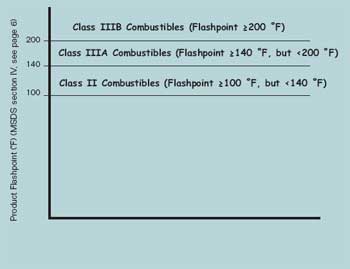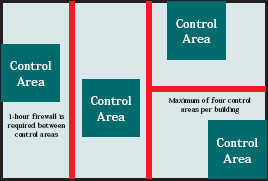Everyday Hazmat User's Training Guide
Section III Hazardous Materials Management (continued)
Combustible Liquids
- Definitions
- Indoor Storage
- Outdoor Storage
- Dispensing
- Transportation
- Examples of Combustible Liquid Products Used in the USDA Forest Service
Combustible liquids are less dangerous than flammable liquids because they have higher flashpoints. Class II combustible liquids have flashpoints between 100 and 140 °F. Class IIIA combustible liquids have flashpoints between 140 and 200 °F. Class IIIB combustible liquids have flashpoints higher than 200 °F. Follow the specific storage, use, and transportation requirements for the appropriate type of combustible liquid.
Definitions

Click on image for larger descriptive view
- See Keeping Incompatible Hazardous Materials Separated
- See Hazardous Materials Storage Cabinets
- See The Transition to Hazardous Waste
- See Hazardous Product Containers
Storage Cabinets
Proper storage cabinets can protect workers and the environment, and can allow you to store larger quantities of combustible liquids safely.
Indoor Storage
Incidental Storage
Storage of combustible liquids is strictly regulated for the safety of personnel and facilities. Incidental storage of combustibles is permissible as long as the quantity does not exceed the maximum allowed, and proper storage containers are used. Permissible quantities differ depending on the occupancy of the building where the incidentals are located. Empty containers previously used for combustible liquids must be stored as if they still contained a combustible liquid.

Floor Plan
Important Requirements
- No more than 10 gallons of flammable and combustible
liquids incidental to the operation and maintenance of equipment, and for
demonstration, treatment, and laboratory work,
outside of an approved cabinet.
- Incidental liquids must be stored in approved
containers and in a garage or other
approved location.
- An approved cabinet must be used to store more than 10 gallons of flammable and combustible liquids incidental to the operation and maintenance of equipment, and for demonstration, treatment, and laboratory work.
Control Areas
Control areas increase the quantity of liquids you can store. However, there are limits. These amounts can be increased if you use approved cabinets and if the area has sprinklers. Several control areas can be used if they are properly separated. Empty containers previously used for combustible liquids must be stored as if they still contained a combustible liquid.

Floor Plan
Click on image for larger descriptive view
Important Requirements
- Avoid storing combustible liquids in basements.
- Containers
with less than 30 gallons capacity may not be stacked more than two containers
or 3 feet high unless they are on shelving or are otherwise secured.
- Containers
that hold more than 30 gallons may not be stacked.
- Containers must be stored
in an upright position.
- Combustible commodities must not be stored above
flammable and combustible liquids.
- Combustible liquids must be at least 3
feet from beams, girders, or other obstructions.
- Combustible liquids must
be at least 3 feet below sprinkler deflectors, discharge orifices, or other
overhead fire protection systems.
- Combustible liquids must not be stored
in the same rack or group as flammable materials.
- The maximum amount of combustible
liquids that can be stored in a control area is: 120 gallons of class II
liquids, 330 gallons of class IIIA liquids, and 13,200 gallons of class IIIB
liquids.
- Amounts
can be increased by 100 percent if proper cabinets are used, and by another
100
percent if the area has sprinklers—not to exceed 300 percent of the original
volume with both cabinets and sprinklers. An unlimited amount of class IIIB liquids
can be stored in buildings
with sprinklers.
- Spill control and secondary containment are required if any individual container has more than a 55-gallon capacity or if the total capacity of all containers exceeds 1,000 gallons.
Interior Rooms
For larger quantities of flammable and combustible liquids, you can use cutoff and inside rooms. A room with one outside wall is a cutoff room, and a room with no outside walls is an inside room. Empty containers previously used for combustible liquids must be stored as if they still contained a combustible liquid.

Floor Plan
Important Requirements
- Cutoff and inside rooms can be used if the storage
volumes of class I, II, and III liquids exceed the amount that can be stored
as incidentals or within control areas inside a building.
- The quantities
of class I, II, and III liquids that can be stored in cutoff and inside
rooms depend on the size of the building and its structural features.
- Check with
your hazmat coordinator for specific structural requirements and safety
features before designating an existing room for liquid storage or constructing
a new
room.
- Spill control and secondary containment are required if any individual container has more than a 55-gallon capacity, or if the total capacity of all containers exceeds 1,000 gallons.
